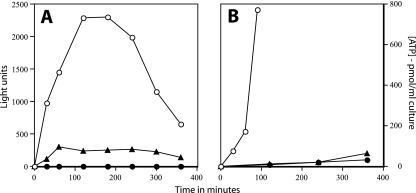FIG. 7.
Light production and ATP accumulation during outgrowth of untreated and heat-killed spores. (A) In populations of PS3379 (luxAB) spores that contained luciferase, 80 or 99% of spores were killed by incubation at 87 to 90°C in water. For the spore population killed at the 99% level, the lower band containing spores that retained DPA but were dead was isolated by equilibrium density gradient centrifugation. For the spore population killed at the 80% level, essentially all spores retained DPA, so these were not fractionated by density gradient centrifugation. The killed spores that retained DPA were germinated in LB medium plus l-alanine, and light production was measured at various times as described in Materials and Methods. ○, untreated spores; •, spores from the lower band in which 97% of spores were dead; ▴, spore population in which 80% of spores were dead. (B) ATP accumulation during outgrowth of untreated and heat-killed spores. In a population of PS533 (wild type) spores, 94 to 99% of spores were killed by incubation at 87 to 90°C in water. For the heat-treated spores, the lower band containing spores that retained DPA but were dead was isolated by equilibrium density gradient centrifugation. The untreated spores and the heat-killed spores that retained DPA were germinated at an OD600 of 5 in LB medium plus l-alanine, and samples were extracted, processed, and assayed for ATP as described in Materials and Methods. ○, untreated spores; •, spore population in which ∼94% of spores were dead; ▴, spore population in which ∼99% of spores were dead. Examination of cultures by phase-contrast microscopy indicated that ∼80% of untreated spores had germinated and many were elongating after 60 min of incubation and that ∼80% of heat-treated spores had germinated after 2 h but none were elongating.

